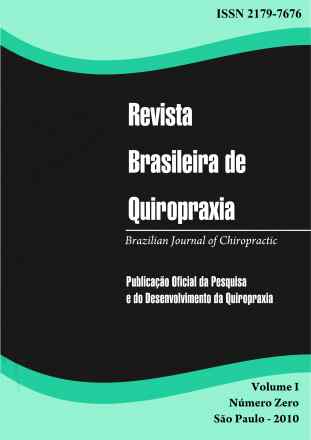A eficácia do ajuste cervical em portadores da Síndrome de Cefaleia Cervicogênica - The effectiveness of cervical adjustment in patients with cervicogenic headache syndrome
Revista Brasileira de Quiropraxia - Brazilian Journal of Chiropractic
A eficácia do ajuste cervical em portadores da Síndrome de Cefaleia Cervicogênica - The effectiveness of cervical adjustment in patients with cervicogenic headache syndrome
Autor Correspondente: Marcelo Todescatt GrittiI | [email protected]
Palavras-chave: Manipulação da coluna, cervicalgia, quiropraxia, cefaleia. Spinal Manipulation, neck pain, chiropractic, headache.
Resumos Cadastrados
Resumo Português:
OBJETIVO: Avaliar a eficácia do ajuste articular na coluna cervical em portadores de sÃndrome da cefaleia cervicogênica. MÉTODOS: Num universo de 18 indivÃduos que buscaram tratamento quiroprático numa clÃnica escola na cidade de Novo Hamburgo, foi selecionado dez, sendo nove do gênero feminino. A hipótese diagnóstica foi realizada tendo como base os critérios da Sociedade Internacional de Cefaleias. Os indivÃduos foram alocados em dois grupos de acordo com a presença de subluxação em C2. O grupo A apresentou desalinhamento em C2 e o grupo B em qualquer outra vértebra cervical. O tratamento totalizou seis atendimentos, duas vezes por semana. As técnicas de ajustes adotadas foram Cadeira Cervical e Modified Rotatory Break. A intensidade de dor foi avaliada pela Escala Visual Analógica de dor e a frequência das crises por relato. RESULTADOS: A média da intensidade de dor pré-tratamento no grupo A foi 5,75 e pós-tratamento 1,5. No grupo B foi de 5,16 e pós-tratamento 0,3. A média da frequência semanal de dor durante as crises pré-tratamento, no grupo A, foi de 4,25 crises e pós-tratamento 0,75 crises. No grupo B, foi 5,16 e pós-tratamento 0,3 crises. Os resultados não apresentaram significância estatÃstica. As vértebras mais acometidas por subluxação, durante o tratamento, foram C2, C1, C3 e C5, respectivamente. CONCLUSÃO: Com base nos resultados obtidos, verificou-se que o ajuste articular foi efetivo na redução dos sintomas em ambos os grupos de indivÃduos, objetos do estudo.
PALAVRAS-CHAVE: Manipulação da coluna, cervicalgia, quiropraxia, cefaleia.
Resumo Inglês:
OBJECTIVE: To evaluate the effectiveness of joint adjustment of the cervical spine in patients with cervicogenic headache syndrome. METHODS: In a population of 18 individuals seeking chiropractic treatment in a clinical school in the city of Novo Hamburgo, Brazil, ten were selected, being 9 women. The diagnosis was made based on the criteria of the International Headache Society. The subjects were divided into two groups according to the presence of subluxation on C2. Group A showed misalignment at C2 and group B in any other cervical vertebra. The treatment totaled six sessions, the frequency of which was twice a week. The adjustment techniques adopted were Cervical Chair and Modified Rotatory Break. Pain intensity was assessed by visual analog scale of pain, and frequency of symptoms by personal report. RESULTS: Comparing drug consumption data before and after treatment, a 71% reduction was observed. The mean pain intensity in the pretreatment group was 5.75, and 1.5 in the post-treatment group. In group B it was 5.16 and 0.3 pre and post-treatment, respectively. The average frequency of weekly pain crises during pre-treatment in group A was 4.25, while post-treatment frequency was of 0.75. In group B was 5.16 and 0.3 post treatment crises. The results were not statistically significant. The most often subluxated vertebrae during treatment were C2, C1, C3 and C5, respectively. CONCLUSION: Based on these results, it was found that joint adjustment was effective in reducing the signs and symptoms in both groups of individuals who were the subject of the study.
KEY WORDS: Spinal Manipulation, neck pain, chiropractic, headache.

